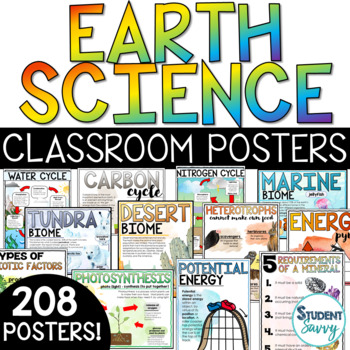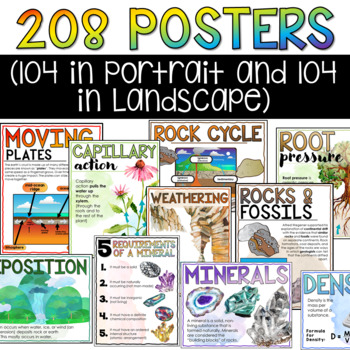Earth Science Posters - Science Classroom Decor - Classroom Posters 6th Grade
- Zip
- Easel Activity
What educators are saying
Products in this Bundle (11)
showing 1-5 of 11 products
Also included in
- Earth Science Bulletin Board Kits (MEGA-BUNDLE 50% OFF)Includes Posters for the following units - Rock Cycle, Plate Tectonics, Rocks and Minerals, Volcanoes, Ecosystems, Earth's Cycles, Photosynthesis, Biomes, Energy, Weather & Climate PostersA total of 208 Posters, 60 Border Styles, and 40 EdiPrice $45.00Original Price $90.00Save $45.00
Description
This bundled resource contains 208 posters - Poster Topics include Rock Cycle, Plate Tectonics, Rocks and Minerals, Volcanoes, Ecosystems, Earth's Cycles, Photosynthesis, Biomes, Energy, Weather and Climate
- These posters are perfect to display in your classroom if you are teaching Science
- Aligned with Earth Science Complete Curriculum
Ready-to-Print PDF files & PNG picture files included in the zip folder
Here is a more in-depth description of all the posters included in the bundle:
Includes the following poster topics: Rock Cycle diagram, Igneous Rock (How it is Formed / Characteristics, Rock Types) Sedimentary Rock (How it is Formed / Characteristics, Rock Types), Metamorphic Rock (How it is Formed / Characteristics, Rock Types), Weathering, Erosion, and Deposition
Plate Tectonics
Includes the following poster topics: Pangaea, Alfred Wegener, Moving Plates, Rocks & Fossils, Geologists, Tsunamis, Volcanoes, Earthquakes, How Plates Move, Seismic Waves, Convective Flow, Rocks and Minerals, Volcanoes, Ecosystems, Earth's Cycles, Photosynthesis, Biomes, Energy, Weather and Climate
Includes the following poster topics: Minerals Overview, 5 Requirements of a Mineral, Weathering, Erosion, Deposition, Luster, Mohs Scale of Hardness, Streak Test, Density, Cleavage and Fractures, Mineral Types
Includes the following poster topics: Parts of a Volcano, Volcanic Landforms, Active Volcano, Geysers, Hot Springs, Fumaroles, Mud Pools, Pyroclastic Flow, Tsunamis, Mudflow, Lava Flow, Volcanic Bombs, Ash
Includes the following posters: Biotic Factors, Abiotic Factors, Ecosystem | Community | Population | Habitat | Niche | Organism, Types of Biotic Factors, Types of Abiotic Factors, Food Chain, Heterotrophs, Autotrophs, Food Web, Natural Events, Human Activities, Energy Pyramid, Soil and the Ecosystem
Includes the following poster topics:
Carbon Cycle (x2)
Nitrogen Cycle (x2)
Water Cycle (x2)
Oxygen Cycle (x2)
Includes the following poster topics: Photosynthesis, Plants (Fun Facts), Chloroplasts, Parts of a Leaf, Parts of a Leaf (External), Root Pressure, Transpiration, Capillary Action, Biomes
Includes the following poster topics:
Kinetic
Potential
Thermal
Electrical
Chemical
Light
Sound
Includes the following poster topics:
Weather, Climate, Barometer, Thermometer, Weather Balloon, Rain Gauge, Anemometer, Reason for the Seasons, Extreme Weather, Global Warming, Atmosphere, Cloud Types
__________________________________________________________________
Tips for Savvy TpT Shoppers:
How to receive credit on TpT to use for future purchases:
• Go to your My Purchases page. Under each purchase you'll see a Provide Feedback button. Simply click it and you will be taken to a page where you can give a quick rating and leave a short comment for the product. I value your feedback greatly as it helps me determine which products are most valuable for your classroom so I can create more for you.
Be the first to know about my new discounts, FREEBIES, and products:
• Look for a green star near the top of any page within my store and click it to become a follower. You will now be able to see FREEBIES and customized emails from my store!
©2021 StudentSavvy
All rights reserved by author. Permission to copy for single classroom use only. Electronic distribution limited to single classroom use only. (unless you purchase the multiple license)
________________________________________________________________
✧✧✧✧✧✧✧✧✧✧✧✧✧✧✧✧✧✧✧✧✧✧
✦✦ ✦Connect with StudentSavvy! ✦ ✦ ✦
✧Click Here to receive notifications on new FREEBIES and teaching resources
✧Newsletter (Receive a FREE Project-Based Learning Activity with Sign-up!)
✧Download a Free Teaching Resources Shopping Guide!
✧✧✧✧✧✧✧✧✧✧✧✧✧✧✧✧✧✧✧✧✧✧✧
_________________________________________________________________






